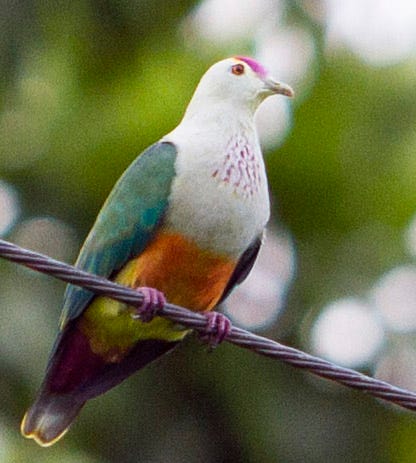Colin Nagy | May 15, 2025
Why Is This Interesting: The Palau Biosecurity Edition
On birds, snakes, and ecosystems
Colin here. I recently returned from Palau, an island in the western Pacific that's home to pristine marine environments and amazing coral reefs (and Scuba!). I wrote about it a bit last year. While remoteness, WWII history, and the photogenic vibe of turquoise lagoons get most of the attention, I was also captivated by the birds. On a very calm morning, just after sunrise, I went out on a boat to do some birding and listen to the beautiful dawn chorus in the trees… except for the owl that interrupted the vibe and sounded like a angry monkey.
Our guide pointed out several species unique to these islands: the vibrant Palau Fruit Dove (the national bird), the elusive Palau Ground Dove, and the peculiar Palau Fantail with its, wait for it, fanned tail flitting through the canopy.
The guide kept returning to a common theme. "We have to be careful," she said. "If certain snakes are introduced to the island, it could destroy everything you're seeing right now."
This passing comment opened a window into something I hadn't considered before: island biosecurity. The concept might sound like jargon, but it's actually one of the most consequential frontlines in global conservation.
Why is this interesting?
From Darwin we all learned that islands are evolutionary experiments that create unique species found nowhere else. But this isolation is also what makes islands susceptible to introduced species. When new predators arrive, native species often have no evolved defenses against them.
The cautionary tale that looms large over the Pacific is Guam. In the 1940s, brown tree snakes accidentally arrived on the island, likely as stowaways on military equipment. What followed was ecological collapse. Within decades, these snakes eliminated 10 of Guam's 12 native forest bird species. Today, Guam's forests are eerily silent, a phenomenon scientists call "silent forest syndrome." A fellow guest on the trip that had previously taught on the Island there as a librarian vividly confirmed this devastation to the group.
But the consequences extend far beyond missing birdsong. Research shows that seed dispersal plummeted without birds, reducing new tree growth. Spider populations exploded without predators to control them. Certain plant species can't effectively germinate without passing through bird digestive systems. One thing tragically let to another.
Palau's approach to biosecurity feels less like paranoid regulation and more like existential defense. At the airport, international arrivals encounter multiple screening layers: X-ray machines scanning for organic materials, dogs sniffing for plants and animals, and detailed declaration forms, similar to arriving in Australia. Cargo containers and even ballast water in ships (which can carry microscopic organisms) are also strictly regulated.
What makes biosecurity interesting is that it sits at the intersection of biology, economics, and global trade. Palau's economy depends on tourism, creating constant tension between accessibility and protection. One innovative solution includes a mandatory "Palau Pledge" that lives as a passport stamp that all visitors must sign upon entry, promising environmental responsibility during their stay. This shifts the mental frame from casual visitor to temporary environmental steward (and hopefully one for years to come).
Biosecurity represents one of the important experiments in prevention versus cure. Keeping invasive species out is infinitely more effective than addressing their impacts after establishment. Just ask Guam, where decades of efforts to control brown tree snakes have cost an estimated hundreds of millions with limited success. (CJN)
